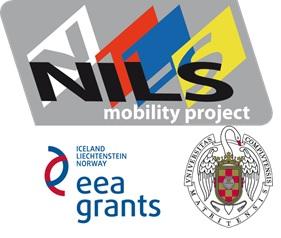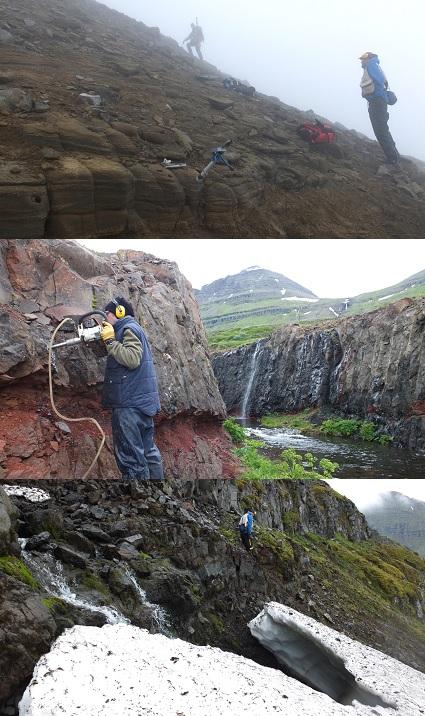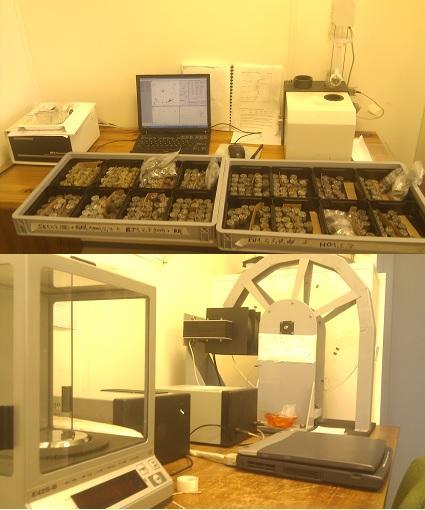| Research |
UCM-EEA
Abel
Extraordinary Chair. Coordinated Mobility of Researchers. NILS Science
and Sustainability (ES07)
“FLOWS
AND BLOWS OF THE ICELANDIC PAST: APPLICATION OF ROCK MAGNETISM TO
UNRAVEL TRANSPORT DYNAMICS OF NEOGENE VOLCANIC ERUPTIONS IN EASTERN
ICELAND”
(004-ABEL-CM-2014A)
(June
2014 - December 2015)

Coordinators at project
promoter / partner institution:
VICENTE
CARLOS RUIZ MARTÍNEZ & MORTEN RIISHUUS SCHIOLDAN
(Universidad
Complutense de Madrid, Spain / Institute of Earth Sciences, University
of Iceland, Iceland)
Supported
by a grant
from Iceland, Liechtenstein and Norway through the EEA Financial
Mechanism.
Operated
by Universidad Complutense de Madrid.
www.nilsmobilityproject.es
Summary
Exceptionally
well preserved volcanic units and groups in eastern
Iceland provide an ideal opportunity for interdisciplinary studies
attempting
to achieve a deeper understanding of the surface dynamics of volcanic
processes
at oceanic spreading ridges. Magnetic particles of such igneous rocks
are
exceptional recorders not only of the ancient geomagnetic field but
also of
fossil flow directions of dykes, lava flows and welded tuffs.
Paleomagnetic and
anisotropy of magnetic susceptibility (rock fabric) studies will be
applied to
determine flow direction and vent sources for specific volcanic
deposits where
structural field evidence is available. The project is planned in
sequential
steps: (i) Fieldwork in eastern Iceland to collect oriented drill cores
from
volcanic rocks, (ii) laboratory treatment and statistical analysis in
Madrid,
and (iii) revisit Iceland for resampling/ collaboration on
interpretations of
results. It will add to our understanding of Icelandic fossil explosive
volcanic processes and tectono-magmatic evolution. Characterization of
ancient
eruption processes aims to add a better understanding of active
volcanic
systems.
Why
the Project was needed:
The
anisotropy of the magnetic susceptibility
(AMS) is a relatively fast method to measure rock fabrics. In addition
to field
observations and rock textures, AMS studies have proven useful to
determine
intrusive and eruptive transport and depositional processes. The past
15 years
have seen a marked expansion in the application of AMS to volcanic
processes.
Recent volcanic events in Iceland (2010 Eyjafjallajökull and
2014-15
Bardarbunga eruptions) have impacted on the public awareness toward the
need
for advancement of our knowledge on many aspects of volcanic hazards.
The
project seeks to contribute to this by attempting to relate rock
fabrics of
pyroclastic density currents and lava flows in the Neogene archives of
eastern
Iceland to eruptive transport and depositional processes.
Workplan
carried out:
Due
to the
2014-15 Bardarbunga volcanic crisis the effectuated work plan has
deviated
significantly from the original planned work plan. According to the
original
plan Vicente Carlos Ruiz Martínez (VCRM) would visit Morten
Schioldan Riishuus
(MSR) in Iceland during summer/early autumn of 2014 for a joint field
campaign.
However, due to the 6-months long eruption that started in late August
2014
(and the preceding volcanic unrest) that required the full-time
participation
of MSR in ground monitoring (and caused the fieldwork to be
unpredictable or an
unhealthy risk), the decision to postpone the field campaign by one
year was
made. This has negatively affected the progress of the project and the
ability
of the co-directors (co-PIs) to hold the planned expenses within a
non-negotiable fixed deadline for final reporting of the mobility
transfers and
research. It also has caused the transferring of funds (<15%)
from
stays to
travels, and the returning of 1320.26 euros (20% of the assigned funds
were not
used):
VCRM
visited
MSR in Iceland in the period July 16-30, 2015, during which fieldwork
was
conducted in eastern Iceland, using the MSR personal vehicle. It is
noteworthy
that, unfortunately, none of the MSR costs during his (Icelandic)
fieldwork
could be funded by the project -neither gasoline nor others-, and all
them were
personally assumed by both co-PIs (approximately the same amount of
money which
was unused at the end of the project).
MSR
made two
stays at Universidad Complutense de Madrid with VCRM (October 19-25 and
November 1-6, 2015) during which planned measurements of anisotropy of
magnetic
susceptibility and hysteresis were performed at the UCM paleomagnetism
laboratory. The two mobility transfers held by MSR also deviates from
the
original plan of one mobility transfer by each of the co-PIs after the
fieldwork had ended. Since data collection took place in
October-November 2015 (during
September, oriented samples were cut in
standard-volume specimens for AMS measurements, and remaining
rock-chips were
classified for rock-magnetic experiments),
there was
no incentive for VCRM to visit MSR at the
University of Iceland at this early stage of the research. Since all
the
analytical work is to be carried out at UCM, the decision was made for
MSR to
complete two transfers at UCM during autumn 2015 to participate in the
data
acquisition.
During
the
mobility transfers to UCM, relevant theoretical and applied research
papers
relevant to the research were discussed as well as the preliminary data
being
collected. Interaction with UCM-based research groups and students was
also
made.
Scientific
activity and results obtained during the project
implementation:
Fieldwork
(Eastern Iceland):
A total of
213
cores were drilled, individually oriented, and retrieved from 24 sites,
including sites from all targeted geological units: Skessa and
Bjólfur tuffs (6
sites); Holmar and Grjótá olivine basalt groups
(7
sites); Kumlafell aphyric
basalt group (5 sites). In addition, lava flows (3 sites), dikes (2
sites) and
a redbed sedimentary unit between flows (1 site) were also sampled.

Paleomagnetic
laboratory (UCM):
Anisotropy of magnetic susceptibility measurements (408 specimens;
KLY-3 rotatory, AGICO) and hysteresis runs (48 curves -2 representative
samples per site-; Coercivity-Spectrometer, Kazan University).

Results:
Magnetic
fabric of Skessa and Bjólfur tuffs showed the higher
grouping of
the principal axes of the AMS ellipsoid, characterized by a markedly
oblate shape, a minimum axis (k3) very close to the vertical, and a
foliation plane -near the horizontal- where the lineation (maximum
axis, k1) is well developed with its azimuth close to that of the
minimum axis k3, which indicate the sense of the pyroclastic density
paleocurrent. These senses, inferred by the magnetic fabric, are
generally compatible with the available geological information (except
1 of the 6 sites, probably affected by an inverse fabric). In the lavas
(basaltic groups Holmar and Grjótá), AMS
ellipsoids
display different degrees of clustering, with both prolate and oblate
shape parameters, and lineations (k1 axis) dipping variably. The
analysis of how paleoflow directions are recorded in different levels
of these lavas is still in progress. Hysteresis parameter ratios were
calculated from loops performed on representative samples of each site,
to determine the grain size of the ferromagnetic minerals (magnetite,
titanomagnetite) present in these volcanic rocks. This information will
help to identify the presence of the "inverse fabrics" related to
monodomain grains, characterized by paleoflow indicators orthogonal to
those recorded in pseudo- and multidomain grains.
(SEE PDFs BELOW)
Seminars,
talks:
On November 3
(2015)
MSR gave a lecture, at the UCM Physics Faculty, titled ‘The
2014-15 tectonic-volcanic episode of the Bárdarbunga
volcanic
system, Iceland: Lateral dyke growth, fissure eruption and lava field
construction’ in a seminar series of the
“Meteorología y Geofísica”
UCM master,
directed toward graduate students at the Faculty of Physics, UCM.
Researchers from the IGN (Instituto Geográfico Nacional)
were
also present. Due to the demands of the fieldwork, VCRM gave no talk at
the University of Iceland.
POSTER at the "NILS -
Closure and outreach event", Collaborative research: Success stories
through and beyond NILS programme May 26 (2016), School of Mathematics,
Universidad Complutense de Madrid: “Magnetic fabrics of
Neogene
pyroclastic density currents from eastern Iceland”: M. S.
Riishuus (Institute of Earth Sciences, University of Iceland, Iceland);
V. C. Ruiz‐ Martínez (Universidad Complutense de Madrid,
Spain).
(SEE *.PDF HERE)
Dissemination of the
project results,
publications prepared within this cooperation scheme and theirs status:
IX CONGRESO
GEOLÓGICO DE ESPAÑA (Huelva, 12-14 September
2016), IX
CONGRESO GEOLÓGICO DE ESPAÑA: “Magnetic
fabrics of
Neogene pyroclastic density currents from eastern Iceland” M.
S.
RIISHUUS & V. C. RUIZ-MARTÍNEZ
M. S. RIISHUUS
& V.
C. RUIZ-MARTÍNEZ (2016). Magnetic fabrics of Neogene
pyroclastic
density currents from eastern Iceland. Accepted for publication in
GEOTEMAS (ISSN: 1576-5172)
(SEE *.PDF HERE)
Further dissemination
(in national and international meetings in the Earth Sciences area) and
publication in international scientific journals (Q1-Q2 following JCR
impact factors) of the project results.
|